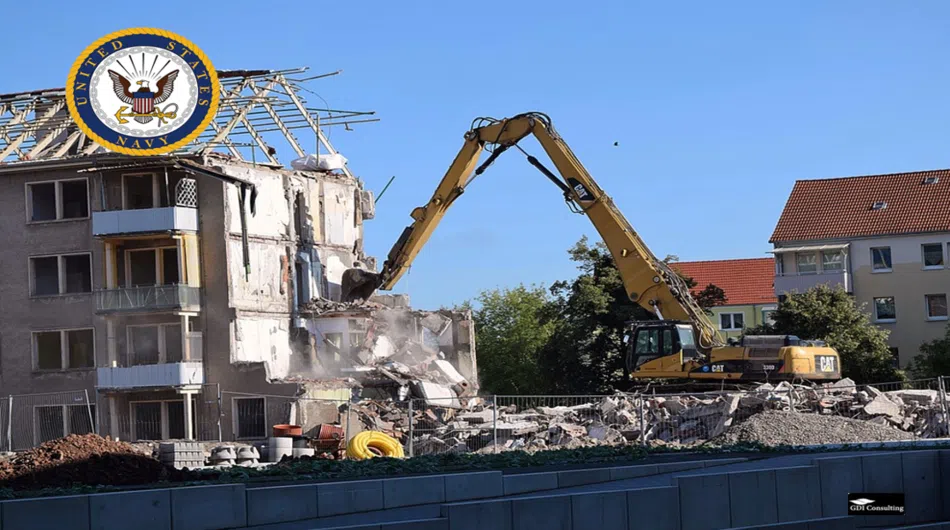Introduction
The U.S. Navy has issued a solicitation for an Indefinite Delivery/Indefinite Quantity (IDIQ) Multiple Award Construction Contract (MACC) for demolition projects at Hunters Point Naval Shipyard (HPNS) in San Francisco, California. The solicitation number is N6247323R1214 and the estimated value of the contract is $999 million over an eight-year period. This article will provide some historical background, RFP description, participation criteria, and challenges for this opportunity.
Historical Background
HPNS was a commercial shipyard established in 1870, and was purchased by the Navy in 1940. It served as a major naval base for shipbuilding, repair, and maintenance during World War II and the Cold War. It was also the site of radiological research and testing, which resulted in contamination of soil, groundwater, and structures. The Navy closed the base in 1974 and transferred most of the land to the city of San Francisco for redevelopment. However, some parcels remained under Navy ownership and were designated as a Superfund site by the Environmental Protection Agency (EPA) in 1989. Since then, the Navy has been conducting remediation and cleanup activities at HPNS, with oversight from EPA and other regulatory agencies.
The Navy has previously issued several solicitations for demolition projects at HPNS, such as N62473-18-R-1402 in 20181, N62473-16-R-2402 in 2016, and N62473-15-R-2401 in 2015. These contracts were awarded to multiple contractors under IDIQ MACC arrangements, with task orders issued for specific demolition requirements. The current solicitation is a continuation of the Navy’s efforts to demolish contaminated structures and facilities at HPNS, as part of its environmental restoration program.
RFP Description
The current solicitation is for an IDIQ MACC for demolition projects at HPNS. The scope of work includes demolition of buildings, structures, utilities, pavements, foundations, and other improvements; removal and disposal of hazardous materials; site preparation and restoration; and incidental related work. The contract will have a base period of five years and an option period of three years. The total contract value is estimated at $999 million, with a maximum task order value of $50 million. The contract will be awarded to multiple contractors on a best value tradeoff basis, considering both price and non-price factors. The non-price factors are past performance, technical approach, management approach, and small business participation.
The solicitation is open to all contractors who can perform the work within the geographic area of responsibility of Naval Facilities Engineering Systems Command Southwest (NAVFAC SW), which includes California, Arizona, Nevada, Utah, Colorado, and New Mexico. The solicitation is set aside for small businesses under NAICS code 238910 (Site Preparation Contractors), with a size standard of $16.5 million. The solicitation requires contractors to have relevant experience in demolition projects involving hazardous materials, radiological contamination, or environmental remediation. The solicitation also requires contractors to have a quality control plan, a safety plan, and a security plan.
Who Should Participate
This opportunity is ideal for small businesses that have experience and expertise in demolition projects involving hazardous materials, radiological contamination, or environmental remediation. Contractors that have previously worked at HPNS or other Superfund sites may have an advantage in demonstrating their technical approach and past performance. Contractors that have strong management capabilities and small business subcontracting plans may also have an edge in the evaluation process. Contractors that are interested in this opportunity should register on the beta.SAM.gov website, where they can access the solicitation documents and submit their proposals electronically.
Challenges
This opportunity poses several challenges for potential contractors, such as:
- The complexity and uncertainty of the work scope: The demolition projects at HPNS involve various types of structures and facilities that may have different levels and types of contamination. The contractors will have to comply with stringent environmental regulations and standards, as well as coordinate with multiple stakeholders and agencies. The contractors will also have to deal with potential changes in the work scope due to unforeseen conditions or discoveries during the demolition process.
- The competition and price pressure: The solicitation is expected to attract many qualified small businesses that have experience in similar projects. The contractors will have to offer competitive prices while maintaining high quality and safety standards. The contractors will also have to balance their risk exposure and profit margin when bidding on task orders under the IDIQ MACC.
- The security and access requirements: The contractors will have to obtain security clearances and badges for their personnel who will work at HPNS. The contractors will also have to follow strict security protocols and procedures when accessing the site or transporting materials or equipment. The contractors will have to ensure that their security plan meets the Navy’s requirements and expectations.
Conclusion
The IDIQ MACC for demolition projects at HPNS is a lucrative opportunity for small businesses that have the capability and capacity to perform the work. The opportunity offers a long-term and stable source of revenue, as well as a chance to contribute to the environmental restoration of a historic naval base. However, the opportunity also entails significant challenges and risks that require careful planning and preparation. Contractors that are interested in this opportunity should conduct thorough market research, develop a compelling proposal, and leverage their strengths and differentiators to win the contract. If you are interested in winning this opportunity contact us today www.gdicwins.com to learn more about how we can help you achieve success.

